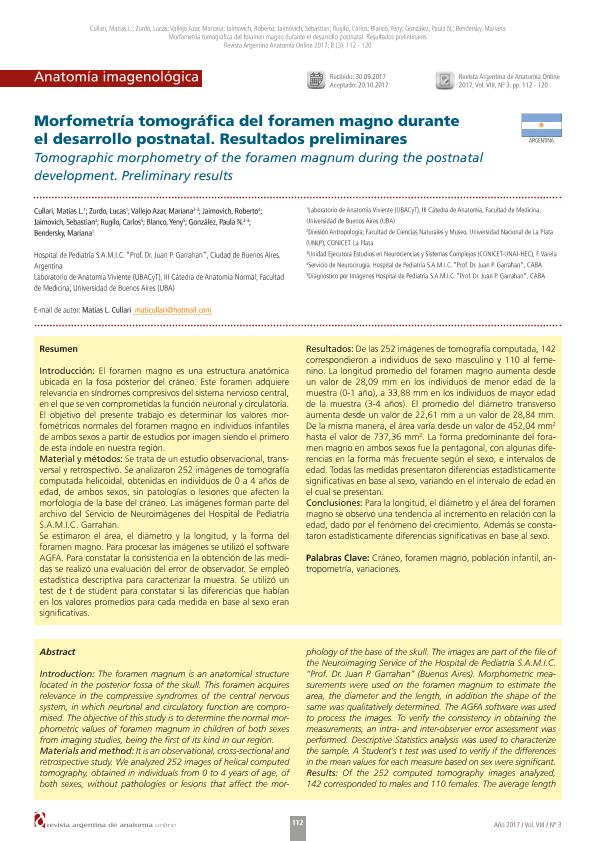Artículo
Introducción: El foramen magno es una estructura anatómicaubicada en la fosa posterior del cráneo. Este foramen adquiererelevancia en síndromes compresivos del sistema nervioso central,en el que se ven comprometidas la función neuronal y circulatoria.El objetivo del presente trabajo es determinar los valores morfométricos normales del foramen magno en individuos infantilesde ambos sexos a partir de estudios por imagen siendo el primerode esta índole en nuestra región.Material y métodos: Se trata de un estudio observacional, transversal y retrospectivo. Se analizaron 252 imágenes de tomografíacomputada helicoidal, obtenidas en individuos de 0 a 4 años deedad, de ambos sexos, sin patologías o lesiones que afecten lamorfología de la base del cráneo. Las imágenes forman parte delarchivo del Servicio de Neuroimágenes del Hospital de PediatríaS.A.M.I.C. Garrahan.Se estimaron el área, el diámetro y la longitud, y la forma delforamen magno. Para procesar las imágenes se utilizó el softwareAGFA. Para constatar la consistencia en la obtención de las medidas se realizó una evaluación del error de observador. Se empleóestadística descriptiva para caracterizar la muestra. Se utilizó untest de t de student para constatar si las diferencias que habíanen los valores promedios para cada medida en base al sexo eransignifcativas.Resultados: De las 252 imágenes de tomografía computada, 142correspondieron a individuos de sexo masculino y 110 al femenino. La longitud promedio del foramen magno aumenta desdeun valor de 28,09 mm en los individuos de menor edad de lamuestra (0-1 año), a 33,88 mm en los individuos de mayor edadde la muestra (3-4 años). El promedio del diámetro transversoaumenta desde un valor de 22,61 mm a un valor de 28,84 mm.De la misma manera, el área varía desde un valor de 452,04 mm2hasta el valor de 737,36 mm2. La forma predominante del foramen magno en ambos sexos fue la pentagonal, con algunas diferencias en la forma más frecuente según el sexo, e intervalos deedad. Todas las medidas presentaron diferencias estadísticamentesignifcativas en base al sexo, variando en el intervalo de edad enel cual se presentan.Conclusiones: Para la longitud, el diámetro y el área del foramenmagno se observó una tendencia al incremento en relación con laedad, dado por el fenómeno del crecimiento. Además se constataron estadísticamente diferencias signifcativas en base al sexo. Introduction: The foramen magnum is an anatomical structure located in the posterior fossa of the skull. This foramen acquires relevance in the compressive syndromes of the central nervous system, in which neuronal and circulatory function are compromised. The objective of this study is to determine the normal morphometric values of foramen magnum in children of both sexes from imaging studies, being the first of its kind in our region. Materials and method: It is an observational, cross-sectional and retrospective study. We analyzed 252 images of helical computed tomography, obtained in individuals from 0 to 4 years of age, of both sexes, without pathologies or lesions that affect the morphology of the base of the skull. The images are part of the file of the Neuroimaging Service of the Hospital de Pediatría S.A.M.I.C. “Prof. Dr. Juan P. Garrahan” (Buenos Aires). Morphometric measurements were used on the foramen magnum to estimate the area, the diameter and the length, in addition the shape of the same was qualitatively determined. The AGFA software was used to process the images. To verify the consistency in obtaining the measurements, an intra- and inter-observer error assessment was performed. Descriptive Statistics analysis was used to characterize the sample. A Student’s t test was used to verify if the differences in the mean values for each measure based on sex were significant. Results: Of the 252 computed tomography images analyzed, 142 corresponded to males and 110 females. The average length of the foramen magnum increases from a value of 28.09 mm in the individuals of lower age of the sample (0-1 year), to 33.88 mm in the individuals of greater age of the sample (3-4 years). The average transverse diameter increases from a value of 22.61 mm to a value of 28.84 mm. In the same way, the area varies from a value of 452.04 mm2 in younger individuals to the value of 737.36 mm2 in older individuals. The predominant form of the foramen magnum in both sexes was the pentagonal, with some differences in the most frequent form according to sex, in some of the age intervals. All the measures presented statistically significant differences statistically based on sex, varying in the age interval in which they occur. Conclusions: For the length, diameter and area of the foramen magnum, a tendency to increase in relation to age was observed, given by the growth phenomenon. In addition, statistically significant differences were found based on sex.
Morfometría tomográfica del foramen magno durante el desarrollo postnatal: Resultados preliminares
Título:
Tomographic morphometry of the foramen magnum during the postnatal development: Preliminary results
Cullari, Matias L.; Zurdo, Lucas; Vallejo Azar, Mariana Nahir ; Jaimovich, Roberto; Jaimovich, Sebastian; Rugilo, Carlos; Blanco, Yeny; Gonzalez, Paula Natalia
; Jaimovich, Roberto; Jaimovich, Sebastian; Rugilo, Carlos; Blanco, Yeny; Gonzalez, Paula Natalia ; Bendersky, Mariana
; Bendersky, Mariana
 ; Jaimovich, Roberto; Jaimovich, Sebastian; Rugilo, Carlos; Blanco, Yeny; Gonzalez, Paula Natalia
; Jaimovich, Roberto; Jaimovich, Sebastian; Rugilo, Carlos; Blanco, Yeny; Gonzalez, Paula Natalia ; Bendersky, Mariana
; Bendersky, Mariana
Fecha de publicación:
09/2017
Editorial:
Argentina Anatomía de Anatomia
Revista:
Revista Argentina Anatomía Online
ISSN:
1853-256X
Idioma:
Español
Tipo de recurso:
Artículo publicado
Clasificación temática:
Resumen
Palabras clave:
Cráneo
,
Foramen Magno
,
Población Infantil
,
Antropometría
,
Variaciones
Archivos asociados
Licencia
Identificadores
Colecciones
Articulos(ENYS)
Articulos de UNIDAD EJECUTORA DE ESTUDIOS EN NEUROCIENCIAS Y SISTEMAS COMPLEJOS
Articulos de UNIDAD EJECUTORA DE ESTUDIOS EN NEUROCIENCIAS Y SISTEMAS COMPLEJOS
Citación
Cullari, Matias L.; Zurdo, Lucas; Vallejo Azar, Mariana Nahir; Jaimovich, Roberto; Jaimovich, Sebastian; et al.; Morfometría tomográfica del foramen magno durante el desarrollo postnatal: Resultados preliminares; Argentina Anatomía de Anatomia; Revista Argentina Anatomía Online; 8; 3; 9-2017; 112-120
Compartir



